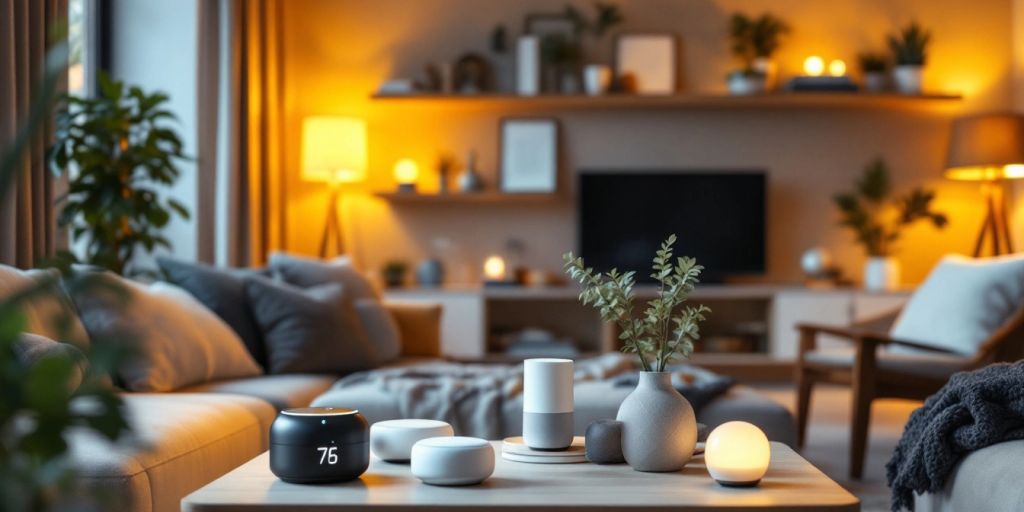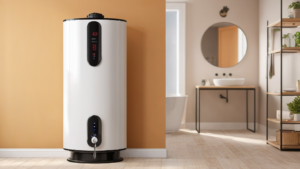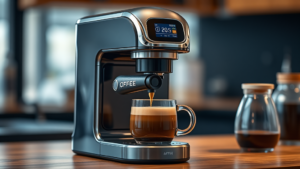Connecting multiple smart home devices can make your life easier and your home smarter. With the right setup, you can control everything from lights to security systems all in one place. This guide will help you understand how to connect multiple smart home devices together for seamless automation, making your home more efficient and enjoyable.
Key Takeaways
- Understand the different protocols and standards for smart devices.
- Choose compatible devices to avoid integration issues.
- Plan your device placement for better connectivity.
- Create automation routines for convenience and efficiency.
- Regularly update your devices to enhance security.
Understanding Smart Home Device Compatibility
In the world of smart homes, compatibility is key. For your devices to work together smoothly, they must be able to communicate effectively. However, this can be tricky due to various factors.
Exploring Different Protocols and Standards
Different smart home devices use various protocols to connect. Here are some common ones:
- Wi-Fi: Widely used but can slow down your network.
- Zigbee: A low-power option that connects many devices.
- Z-Wave: Similar to Zigbee but operates on a different frequency.
| Protocol | Range | Power Consumption | Common Devices |
|---|---|---|---|
| Wi-Fi | Up to 300 ft | High | Cameras, Speakers |
| Zigbee | Up to 100 ft | Low | Smart Bulbs, Sensors |
| Z-Wave | Up to 300 ft | Low | Locks, Thermostats |
The Role of Smart Home Hubs
Smart home hubs are essential for connecting devices that use different protocols. They act as a bridge, allowing devices to communicate. For example, you can connect your smart light bulbs and thermostat through a hub, making it easier to control everything from one place. Matter is a new protocol that supports many devices, allowing you to connect your smart home device directly to Alexa with the matter connectivity protocol.
Common Compatibility Challenges
Many homeowners face challenges with compatibility, such as:
- Different Standards: Not all devices work with each other.
- Closed Ecosystems: Some brands only allow their devices to connect.
- Limited Features: Even if devices connect, they may not support all functions.
To create a truly connected home, it’s important to choose devices that can work together seamlessly.
By understanding these aspects of compatibility, you can make better choices when setting up your smart home system.
Choosing the Right Smart Home Devices
When it comes to setting up your smart home, selecting the right devices is crucial. Here are some key points to consider:
Identifying Your Automation Needs
- Think about what you want to automate. Do you need smart lights, security cameras, or smart speakers?
- Make a list of tasks you want to simplify, like controlling lights or monitoring your home.
- Consider how many devices you want to connect and their locations in your home.
Researching Device Compatibility
- Check if the devices work with your chosen smart home ecosystem, like Google Home or Amazon Alexa.
- Look for devices that support multiple protocols, such as Zigbee or Z-Wave, for better connectivity.
- Verify that the devices can communicate with each other, which is essential for seamless automation.
Selecting Reliable Brands
- Stick with well-known brands that have a reputation for quality. This ensures better support and updates.
- Read reviews and check ratings to find the best smart home devices of 2024.
- Consider the warranty and customer service offered by the manufacturer.
Choosing the right devices can make your smart home experience enjoyable and efficient.
By following these steps, you can create a smart home that meets your needs and works smoothly together. Remember, the goal is to make your life easier and more connected!
Setting Up Your Smart Home System

Setting up your smart home system can be exciting and a bit tricky. Here are some steps to help you get started:
Planning Device Placement and Connectivity
- Choose the right spots for your devices. Make sure they are near power outlets and have a good Wi-Fi signal.
- Think about accessibility, especially for battery-powered devices that need charging.
- Test each device in its spot before installing it permanently.
Installing and Testing Devices
- Purchase your devices based on your needs and compatibility.
- Follow the manufacturer’s instructions for installation. Some devices are easy to set up, while others may need a professional.
- After installation, test each device to ensure it works properly.
Configuring Your Smart Home Hub
- If you have a smart home hub, set it up according to the instructions. This hub will help you control all your devices from one place.
- Customize your system by setting schedules and creating scenes that fit your lifestyle. Explore the features to make the most of your smart home.
Remember, patience is key! It may take time to get everything working perfectly, but the effort will pay off in convenience.
By following these steps, you can create a smart home that meets your needs and enhances your daily life. Learn how to set up a smart home by diving into the essentials of the installation process with Techopedia’s 2024 guide.
Creating Seamless Automation Routines

Grouping Devices for Simplified Control
To make your smart home easier to manage, grouping devices is essential. Instead of controlling each device separately, you can organize them into groups. For example, instead of saying, "Turn on living room light 1," you can simply say, "Turn on living room lights." This saves time and makes your commands simpler.
Scheduling Automated Tasks
You can set up your devices to perform tasks automatically at specific times. For instance, you might want your robot vacuum to start cleaning every day at 10 AM. This way, your home stays clean without you having to remember to do it. Here are some tasks you can schedule:
- Turn on lights at sunset.
- Adjust the thermostat before you arrive home.
- Start the coffee maker in the morning.
Utilizing Voice Commands and AI
Voice commands make controlling your smart home even easier. With just a few words, you can manage multiple devices at once. For example, saying "Good morning" can trigger your smart home to open the curtains, turn on the lights, and start the coffee maker. This integration of voice commands allows for a more connected and user-friendly experience.
Automating your home can greatly enhance your daily life, making tasks easier and more efficient.
By following these steps, you can create a smart home that works seamlessly for you, allowing for a more comfortable and convenient living environment. Remember, the key to effective home automation integration lies in ensuring that all devices are compatible with each other and can communicate using common protocols.
Troubleshooting and Optimizing Your Smart Home

Setting up a smart home can be tricky, and sometimes things don’t work as planned. Here are some helpful tips to get everything running smoothly:
Testing and Troubleshooting Common Issues
- Check your Wi-Fi connection. Make sure your phone and the smart device are on the same Wi-Fi band, usually 2.4 GHz.
- If a device won’t connect, try restarting it and your router. This simple step can solve many problems.
- Look for help online. Search for your device model and the issue you’re facing; you might find a solution from others who had the same problem.
Regularly Updating Device Firmware
- Keeping your devices updated is crucial. Regular updates can fix bugs and improve performance. Check the app for your device to see if updates are available.
- Set reminders to check for updates every few months to ensure your devices are secure and functioning well.
Enhancing Security and Privacy
- Use strong, unique passwords for each device. This helps protect your smart home from unauthorized access.
- Enable two-factor authentication if available. This adds an extra layer of security to your devices.
- Regularly review the privacy settings of your devices to control what data is shared.
Remember, troubleshooting is a normal part of setting up your smart home. Don’t get discouraged if things don’t work right away; patience and persistence are key.
By following these tips, you can optimize your smart home experience and enjoy the benefits of automation without the headaches. For more smart home automation tips and tricks, check out our best smart home tips to see how you can optimize your system and create a home that’s smart, secure, and protected.
Exploring Advanced Smart Home Features

Integrating Security Systems
Integrating security systems into your smart home can greatly enhance safety. Smart cameras, door locks, and motion sensors work together to provide a comprehensive security solution. This integration allows for real-time alerts on your smartphone, so you can monitor your home from anywhere. Here are some key benefits:
- Remote monitoring through live video feeds.
- Instant notifications for suspicious activity.
- Ability to lock/unlock doors remotely.
Enhancing Entertainment Experiences
Smart home technology can transform your entertainment setup. With a centralized control system, you can manage audio and video devices easily. For example, you can create a movie night scene that dims the lights and turns on the TV with a single command. Here are some features to consider:
- Voice control for hands-free operation.
- Custom scenes for different activities.
- Integration with streaming services for seamless access.
Utilizing Remote Access and Monitoring
Remote access is a game-changer for smart homes. It allows you to control devices from anywhere using your smartphone. This feature is especially useful for managing energy consumption and ensuring your home is secure. Here are some advantages:
- Monitor energy usage and adjust settings remotely.
- Check on pets or kids while away.
- Receive alerts for unusual activity or system malfunctions.
Smart home technology is not just about convenience; it’s about creating a safer and more enjoyable living environment.
By exploring these advanced features, you can maximize the potential of your smart home. Whether it’s for security, entertainment, or remote management, the right devices can make a significant difference in your daily life. Remember, choosing the best smart home devices for 2024 can set you up for success in creating a seamless automated experience.
Final Thoughts on Smart Home Integration
In conclusion, connecting multiple smart home devices can greatly enhance your daily life. By bringing together different gadgets, you can create a home that works for you, making tasks easier and more efficient. Start small by choosing a few devices that meet your needs, and gradually add more as you get comfortable. Remember to check for compatibility and consider using a smart home hub to manage everything from one place. With a little planning and effort, you can enjoy a seamless smart home experience that saves you time and adds convenience to your life.
Frequently Asked Questions
What is home automation integration?
Home automation integration means connecting smart devices in your house to work together smoothly. This lets you control everything from one place.
What are the advantages of home automation integration?
Home automation integration makes life easier, saves energy, improves security, and can save you money.
Which devices can I connect in a home automation system?
You can connect many devices like smart thermostats, lights, security cameras, door locks, and entertainment systems.
What is a smart home hub?
A smart home hub is a central device that links and controls all your smart devices in one system.
Do all smart devices work with all smart home hubs?
No, not every smart device works with every hub. You need to check if they are compatible before buying.
Is it hard to set up home automation integration?
How hard it is to set up home automation depends on how complex the system is and how comfortable you are with technology.



